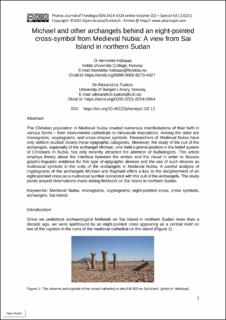| dc.description.abstract | The Christian population in Medieval Nubia created numerous manifestations of their faith in various forms – from monumental cathedrals to minuscule inscriptions. Among the latter aremonograms, cryptograms, and cross-shaped symbols. Researchers of Medieval Nubia have only seldom studied closely these epigraphic categories. Moreover, the study of the cult of the archangels, especially of the archangel Michael, who held a primal position in the belief system of Christians in Nubia, has only recently attracted the attention of Nubiologists. This article employs theory about the interface between the written and the visual in order to discuss grapho-linguistic evidence for this type of epigraphic devices and the use of such devices as multivocal symbols in the cults of the archangels in Medieval Nubia. A careful analysis of cryptograms of the archangels Michael and Raphael offers a key to the decipherment of an eight-pointed cross as a multivocal symbol connected with the cult of the archangels. The study pivots around observations made during fieldwork on Sai Island in northern Sudan. | |
